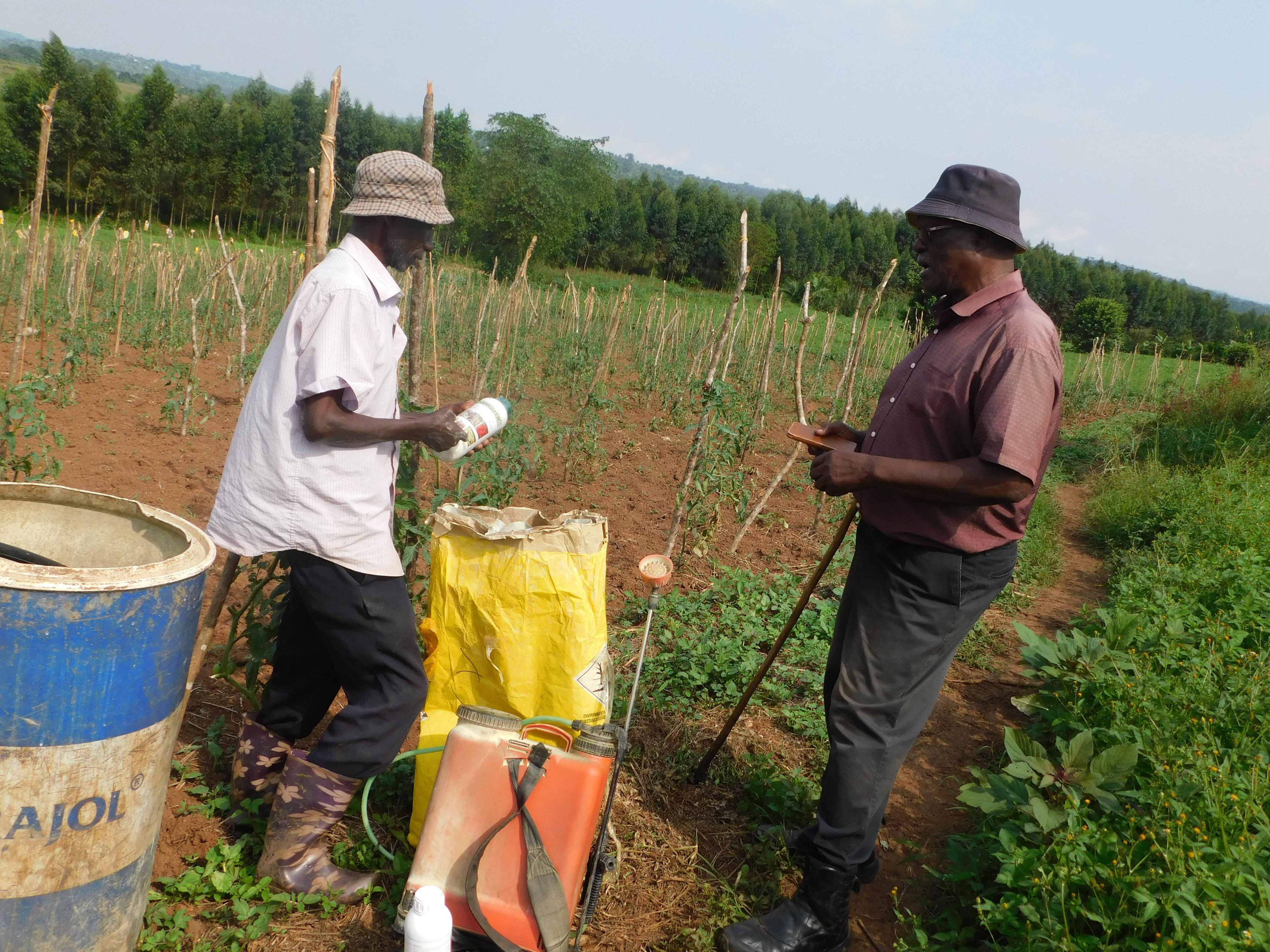Prime
Prioritising sound management of agrochemicals

(Left) Gerald Ssendaula (right) gives instructions to one of the farm employees about how much pesticide to apply. Photo/Michael J Ssali
What you need to know:
- Each year, there are reports of farmers who suffer losses because of the incorrect use of agrochemicals. This can be due to using the wrong products, such as when a herbicide is mistaken for a pesticide, or the incorrect use of the right product
According to a recently released report by the Food and Agriculture Organisation (FAO) titled: “Crop losses due to disease and their implications for global food production losses and food security,” pathogens, wild animals, birds, rodents, and weeds are altogether responsible for losses ranging from 20 percent to 40 percent of global food productivity. The dictionary meaning of pathogen is “a thing that causes disease”.
For crops and farmed animals this may be in the form of pests, fungi, parasites, and bacteria. Farming is a constant battle between the farmer and weeds, pests, parasites, and bacteria. Often farmers also have to fight wild animals, rodents, and crop eating birds.
They therefore, usually turn to using agrochemicals as one of the main weapons in the battle to protect their crops and livestock. Agrochemicals must however be handled and used very carefully to be really effective. If they are not applied according to manufacturers’ instructions they may not help and the farmers may end up complaining that the agrochemicals are fake.
Guided use
Dr Paul Kanoonya, retired Masaka District production officer, says, “Veterinary drugs may not be effective if there is a breakdown in the distribution and control chain.
Acaricides are drugs applied on the skins of animals to kill external parasites such as fleas, ticks, mites, flies and others. They should be purchased from licensed vet pharmacies under National Drugs Authority (NDA) and manned by people holding diplomas or degrees in veterinary medicine.
These should guide the farmers about how to use the drugs. Farmers may further seek guidance from field veterinary officers in the respective farmers’ localities. When this is not done then we have what I have referred to as a breakdown in the vet drugs distribution and control chain.”
Dr Kanoonya goes on to say that due to the breakdown there are cases of over dilution of the drugs by the farmers which compromises their effectiveness. He further says that in some cases expired drugs which have spent too long in the pharmacies may be sold to the farmers by unscrupulous dealers. He adds that there is a possibility of nonprofessional vets setting up vet pharmacies.
Dr Kanoonya also mentions the issue of drugs entering Uganda outside the control of NDA given our porous borders and the big drive by some people to make money at whatever cost. He said fake drugs are chemically ineffective and farmers must be careful about where they purchase their drugs.
Dr Kanoonya goes on to say, “We then have drugs which are applied through the mouth to kill internal parasites such as worms inhabiting the liver, the stomach, and intestines. These too should be purchased from licensed vet shops manned by well trained and qualified vet professionals capable of giving user instructions to the farmers exactly like is the case of acaricides. Where there is a breakdown in the distribution and control of the products, farmers who are the end users make losses and complain about ineffectiveness of drugs.”
He says the third category of vet drugs are drugs injected into the animals using syringes and needles. They include vaccines and antibiotics.
“By law no farmer is allowed to handle these drugs,” he says. “Only technically trained and qualified vet professionals are allowed to apply such drugs.”
John Mugera, retired agricultural services extension officer in Masaka District, says that in most cases it is the farmers who do not take the trouble to find out how to use the agrochemicals properly.
“First of all most of our farmers cannot read and understand the English language that is used on the leaflets that come with the drugs,” he says.
“They just put the herbicides blindly into water and end up with an ineffective solution which they spray over the weeds. When it does not work they complain that the products are fake. Many of them don’t want to listen to extension workers especially when he or she does not own a farm.
They claim he only has theoretical knowledge about farming issues. But misuse of herbicides and pesticides can be harmful to both the farmers and the food consumers because the items are basically poisonous.” He however agrees that in some cases there are fake agro-chemicals on the market which must be fought by the government and all other stakeholders.

A farmer sprays acaricide on his cows to kill external parasites like ticks and fleas. Photo/Michael J Ssali
Training
Only 23 percent of farmers in Uganda have received training in pesticide and herbicide use such as proper application techniques, storage, and safety measures, according to a study made by PHE (Pesticide Use, Health and Environment Project) and UNACOH (Uganda National Association of Community and Occupational Health) whose results were released in 2019.
In its report dated June 23, 2017 the Food and Agriculture Organization (FAO), relates agro-chemicals misuse to soil depletion and human health problems.
It says “Mindless use of agro-chemicals leads to soil pollution. Excess nitrogen and trace metals such as arsenic, cadmium, lead and mercury can impair plant metabolism and cut crop productivity, ultimately putting pressure on arable land. When they enter the food chain, such pollutants also pose risks to food security, water resources, rural livelihoods and human health.”
Often powder pesticides are even noticeable on vegetables and fruits laid out for sale in our public markets. Some farmers use pesticides to keep crops in stores. How sure are we that the drugs have been safely applied?
It is generally feared that farmers are producing food contaminated with chemicals sprayed on them in the process of production.
The above mentioned study titled: “Pesticide use in Uganda – Perspectives for Human and Environmental Health” conducted by Dr Aggrey Atuhaire and Dr D K Sekimpi reveals that a total of eight different pesticide residues were found in tomatoes randomly collected from smallholder farms in all the four geographical regions of Uganda.
“Of concern was Mancozeb (a Dithiocarbamate contact fungicide) which was found in much higher concentrations than the rest in detectable levels for all the samples from the farm and market,” reads the study report.
The study report also revealed that almost all the eighty-six water sources sampled across the country had at least one detectable concentration of a pesticide residue.
The cost of pesticides and herbicides is also a big worry to the farmers apart from being a health risk to both producers and food consumers. To produce such crops as Irish potatoes, tomatoes, and cotton the farmers must spend big amounts of money on pesticides which reduces their profits. Secondly not all pests attacking and wiping out important food crops such as cassava, bananas, maize and sweet potatoes have a chemical cure.
Writing in the Daily Monitor on October 9 2015, Dr Wilberforce Tushemeirwe, who was by then head of the National Agricultural Research Organization (NARO), said, “The big population increase is set to dramatically raise the demand for food supplies. Yet our food crops are facing extinction and there are no known ways of effectively dealing with the new pests and diseases other than the use of biotechnology.”
The government which has always facilitated NARO to carry out successful biotechnology research is also aware that modern biotechnology is one of the best tools to use to fight poverty and to achieve food security since it has proven effective in mitigating the agricultural challenges of many other countries across the world. Speaking on World Food Day (October 16, 2015) President Museveni said, “Biotechnology is to impart certain qualities and legislators who are against it should modernize their thinking.”
His entire speech that day reveals his supportive of biotechnology and the work so far done by the scientists and the achievements they had made.
Key fact
Storing hazardous products
1. The way in which chemicals are stored, as well as the place where they are stored, has to conform to legislation.
2. Typically, chemicals are stored in a well-ventilated building constructed out of bricks and concrete. The building should also have enough fire extinguishers, with the number required depending on the size of the building.
3. By law, red-label or toxic products should be locked up separately to keep them safe. It is also good practice to separate herbicides, fungicides, pesticides and other agrochemicals to prevent mistakes.




